Translate this page into:
Hair cosmetics
2 Dr. Madnani's Skin and Hair Clinic, Colaba, Mumbai, India
Correspondence Address:
Nina Madnani
P.D. Hinduja National Hospital, Veer Savarkar Marg, Mahim - 400 016, Mumbai
India
| How to cite this article: Madnani N, Khan K. Hair cosmetics. Indian J Dermatol Venereol Leprol 2013;79:654-667 |
Abstract
The hair cosmetic industry has undergone a revolutionary change over the last two decades. The focus has dramatically veered from merely cleaning to repair, increasing the tensile strength, reducing oxidative damage, and stimulating growth. Newer shorter procedures to make hair look naturally more lustrous, smooth, and manageable have evolved. Specialized grooming products have been formulated to cleanse, calm, and condition the hair, and are tailored for different hair-types, for example, dry, dry-damaged, oily, colored, and gray hair. Other products are formulated to alter the color or structure of the hair shaft, for example, hair dyes, perming/relaxing. Hair sprays and waxes/gels, can alter the 'lift' of the hair-shaft. Although dermatologists are experts in managing scalp and hair diseases, the esthetic applications of newer cosmetic therapies still remain elusive. This article attempts to fill the lacunae in our knowledge of hair cosmetics and esthetic procedures relevant in today's rapidly changing beauty-enhancing industry, with special emphasis on the Indian scenario for chemical and 'natural' hair products.Introduction
A ′healthy′ head of hair is described as hair that has luster, is smooth, long and silky, bouncy, with good volume, and with no evidence of balding. [1] To achieve this, the hair-care industry has provided us with a plethora of products to beautify, enhance, strengthen, and ′nourish′ our tresses. Most of the products work at the cuticle level of the exposed hair shaft. A few can enter the cortex. Some hair procedures like coloring, perming, straightening, and the like, result in structural damage. Specialized products then have to be used to repair and restore (if possible) the natural hair integrity. Hair dressing has evolved from just cutting, to altering the color, texture, and ′health′ of the hair. Frizzy hair can be straightened and straight hair can be curled. Understanding the structural components is essential to understanding ′hair care′.
Structure and Physical Characteristics of Hair
Healthy hair is pigmented, smooth, glossy, and flexible yet strong, with the ability to withstand shearing forces. The hair gloss depends upon the smooth layering of the cuticle, while the strength depends on the integrity of the cortex, which is made up of 15% hard keratin (skin contains 2% keratin).
Hair cosmetics act on the part of the hair shaft that projects beyond the scalp surface. The hair consists of a cortex surrounded by a multilayered complex cuticle with/without a central medulla. The cuticle has a very important role to play in regulating the entry and exit of chemicals/water to and from the cortex. It provides protection from external environmental factors, and when intact, keeps the hair surface smooth and glossy.
The cuticle is six to eight layers thick and closely adherent to the inner cortical layer of the hair shaft. It is damaged in procedures that require disruption of the cortex, such as, bleaching, coloring, and perming. The individual cuticular cells are made up of proteins, lipids, and polysaccharides. The cells are colorless and arranged in an overlapping, roof tile-like pattern, providing for an impenetrable barrier to external environmental damage. The open ends of the overlapping tiles are directed away from the scalp, toward the growing tip. The adjacent hair grows and moves outward in relation to each other. This arrangement facilitates the lifting up of dirt and scales, helping for easy removal. [2] The cells overlap such that only one-sixth of each surface is exposed. The outermost layer of cells forming the cuticle is called the epicuticle, a hydrophobic layer, providing for the first line of defense against water. Immediately below is the A-layer, which is high in cysteine content. The thiol groups of adjacent cysteine residues undergo oxidation to form disulfide bonds. This cross-linkage confers structural strength and rigidity to the cuticle. The subsequent layers have progressively less cystine content and correspondingly less rigidity. The B-layer or the exocuticle lies immediately below, followed by the endocuticle. The endocuticle has the least cystine content and is much softer. S100A3 is an important protein component of the endocuticle, and is released during harsh chemical procedures resulting in instability of the hair structure. [3] It is this layer that absorbs water and swells up, allowing for change is the physical properties of hair. Finally, the cellular membrane complex (CMC) separates each cell from the one below. 18-methyleicosanoic acid (18-MEA) is an important lipid component of this hydrophobic layer. In many ways, the cuticle is similar to the stratum corneum of the epidermis. An intact, well-organized cuticle is representative of healthy hair.
The cortex lies immediately beneath the cuticle and forms the major component of human hair. It consists of fusiform spindle cells approximately 100 microns long, arranged longitudinally. Each spindle cell has microfibrils and macrofibrils within a cystine-rich matrix. The cells are held together by an intercellular substance and have complex keratins numbering 1-17. Disulfide bonds between the cysteine residues within the cortex are the strongest and structurally the most important bonds that hold the keratin proteins together. They are responsible for the ultimate shape of the hair. These bonds have to be dissolved during the procedures that change the shape of the hair. Hydrogen bonds exist as weaker bonds that can stretch during simple wetting of hair. The Van-der-Waal forces and Coulombic interactions (salt-links) are the weaker bonds present. The cells of the cortex contain melanosomes that are responsible for the color of the hair. Hair color is almost completely dictated by the presence of either pheomelanins (red) or eumelanins (brown/black) within the melanosomes. Interestingly, the melanosomes are more densely arranged in the outer layers of the cortex than at the central core.
The medulla is at the core of the hair fiber. It is highly variable in human hair and is made up of specialized cells with air spaces in between. It is rich in glycogen and citrulline. It is present only in the thick dark hair of the scalp and is lost in the aging gray hair. Its function is not known.
The structure of unprocessed hair is perfectly designed and its outermost layer remains smooth, well-protected, dries quickly when wetted, and resists diffusion of water into the cortex. [4] This maintains the structural integrity.
Weathering of Hair
The hair surface in untreated hair has a pH of 4.5 to 5.5. This acidic pH helps to keep the cuticular cells closely opposed to the cortex. Damage to the cuticle results in structural changes to the hair shaft over a period of time and constitutes hair weathering. As the scalp hair of women grows over long anagen periods, the hair is exposed to several years of cumulative damage from external factors [Figure - 1]a. The contributing factors include chronic ultraviolet exposure, excessive wetting, repeated harsh chemical procedures [Figure - 1]b, hot combs, blow-drying, and even simple, but repeated activities, such as rough combing and brushing. [5],[6] Loss of cuticle or lifting-up of the cuticular plates exposes the cortex that is then readily susceptible to damage resulting in split ends (trichoptilosis) and frayed tips. Weathered hair loses moisture more rapidly than normal hair, and hence, looks dull and dry. [7] Weathering is not a common occurrence in men (except those with long hair styles) as their hair are constantly cut, which helps the damage (if any) to be trimmed off. Hofbauer Tsambaos, Spycher, and Trueb have reported that the excessive weathering seen in areas of androgenetic alopecia is due to a low threshold to damage caused by changes of acquired pili annulati. [8] Environmental dust, dirt, sebum accumulation, and hair products build up on the hair making it sticky, dull, and often unmanageable. This is termed as a ′bad hair day′. Copper from tap water in copper water pipes gets deposited on the hair during washing. Being a catalyst, it liberates free radicals and causes the hair to become dull and damaged. Fortunately in India, we do not have copper water pipes. Water from wells also has a very high mineral content, which can get deposited on the hair shaft. Hair washed with such water can also damage the hair.
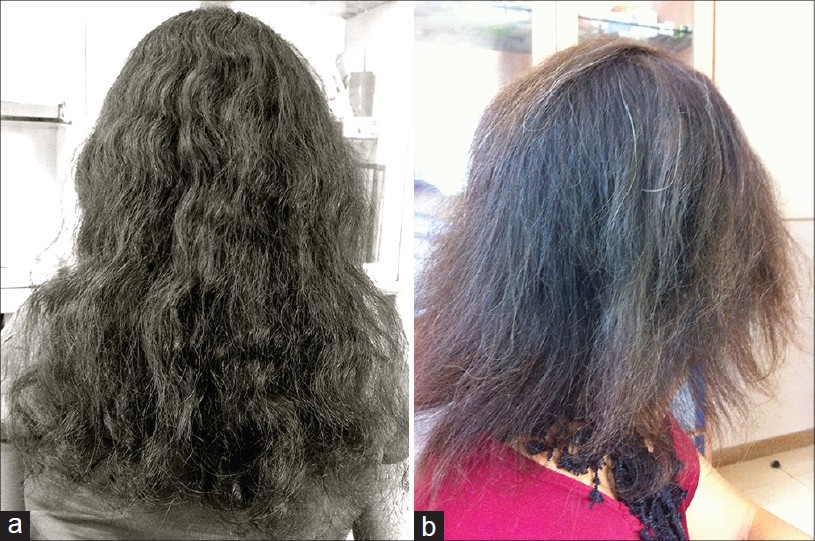 |
| Figure 1: (a and b) Naturally weathered hair, Weathered following cosmetic procedures |
Classification of Hair Cosmetics
The various components of hair at the molecular level regulate the efficacy of various hair cosmetic products, allowing their classification as follows:
Category 1: Those that work on the exocuticle
Category 2: Those that work on the cortex or alter the structural integrity of the hair shaft.
Category 1
These hair cosmetics include shampoos, conditioners, serums, hair sprays, waxes, gels, mousses.
Shampoos
Traditionally, the beauty of Indian ladies was measured by the length of their hair and many had plaited hair reaching upto their knees. Maintaining a good scalp and hair hygiene was a very important part to healthy hair. The concept of hair cleansers used in ancient India gave rise to the word ′shampoo′ (India: Champo). Hair cleansers were made by boiling soapnut (Reetha; Sapindus Mukorossi) with Indian gooseberries (Aamla; Phyllanthus emblica) and shikakai (Acacia concinna) in water and using the strained water to wash the hair. The other option was using a paste of Fuller′s earth (multani matti) on the scalp and rinsing it off with water. The Fuller′s earth would adsorb the grease, which was then rinsed off. These natural cleansers left the hair dry, and hence, people moved onto using shampoos formulated with better conditioning properties.
Shampoos are formulated for cleansing the hair. Although historically, that was their only function, today specialized benefits are expected, almost magical, where shampoos are expected to give shine, volume, easy combability, protection of colored hair from fading, ultraviolet protection, and so on. The media hype has been responsible for these heightened expectations from a product, which in the past merely served to clean the hair.
All shampoos have certain basic ingredients [9] like: [Table - 1]
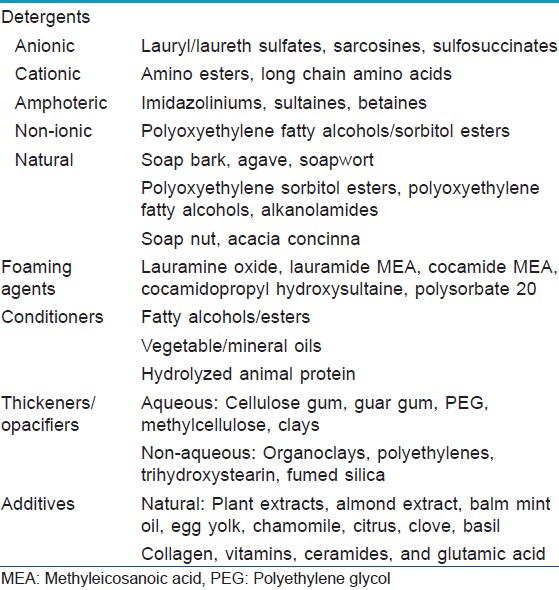
- Detergent
- Foaming agents
- Conditioners
- Thickeners
- Opacifiers
- Sequestering agents
- pH adjusters
- Preservatives
- Additives
These are surfactants that combine and emulsify and wash off the grease and dirt (soil). Various types of surfactants are formulated to cleanse different types of hair [Table - 2]. The most popular in use are sodium laurel/laureth sulfates, ammonium lauryl/laureth sulfates, triethanol amine lauryl sulfate, diethanol lauryl sulfate, and sodium olefin sulfate. Also, a detergent, to be very effective in cleansing the hair, would also strip the hair of sebum, leaving them dry.

Foaming agents
These are very popular in shampoos, as historically, people equate efficacy with foaming of the shampoo. Greasy hair will require repeated washing with shampoo, until the shampoo foams properly.
Conditioners
An effective cleanser will strip the hair of all grease, thus leaving it dry and dull. Hence, shampoos incorporate various ingredients that can coat the cuticle to improve shine, slip, and easy combability.
Thickeners and opacifiers
These appeal to the aesthetic sensibilities of the user, but do not add to the cleansing effect. They have to be compatible with the surfactants. Although alkanolamides were the early agents used, they have been replaced with various aqueous and non-aqueous agents. The consumer equates thickness with a better aesthetic look and efficacy. Betaines combine with the anionic surfactants to make large micelles, and also contribute electrolyte salt that increases the viscosity of the product.
Sequestering agents
A detergent, when used with hard water, leaves a sticky residue on the surface. This scum renders the hair dull and unmanageable. This is often seen when soap is used to cleanse the hair. Sequestering agents prevent the formation of this scum by chelating the calcium and magnesium ions from hard water.
pH adjusters
Damaged hair can swell with alkaline detergents. Hence, when formulating suitable shampoos for such hair, an acidic pH adjustment is done. The substances used includes citric and lactic acid.
Additives
Various additional agents are added to shampoos to either give better conditioning or to term them as a ′natural′ or a herbal shampoo.
Depending upon the nature of the detergent used, shampoos are targeted for various hair types. Proper shampooing involves wetting the hair completely, taking a good amount of shampoo in the palm and then applying it along the head and length of hair. Hair should not be piled up on top of the head before applying the shampoo as this can lead to matting of hair. [10]
Conditioners
Conditioners fulfill the need for hair shaft protection and are agents either incorporated into shampoos or used after cleansing, on slightly damp hair. After a shampoo wash, the cuticles get slightly lifted, and the hair develops a negative charge causing the hair to repel each other and appear rough and uncombed. Conditioners flatten the cuticles and seal the gaps that could expose the important cortex to environmental damage. Conditioning agents incorporated into shampoos (labeled as conditioning shampoos/dry hair shampoos/hair fall shampoos) include mineral oils, vegetable oils, fatty alcohols/esters, humectants, hydrolyzed animal proteins, glycerine, stearalkonium chloride, propylene glycol, silicones (dimethicone, simethicone), and natural products like bees honey (an emulsion of proteins sugars and lipids), vinegar, wheat germ oil, panthenol, collagen, and placenta. Silicones have become very popular as they provide good ′slip′ and luster, and retain moisture in the hair, but silicone oil is hydrophobic and it does not get absorbed onto the hair very easily.
Sebum is a natural conditioner for the hair. By capillary action, the excreted sebum, coats only the proximal 1.5 inch of the hair shaft. It is the process of combing that helps to distribute the sebum distally and coat the hair evenly. An ideal conditioner, if it did exist, would need to match the components and natural properties of sebum. Hence, they would need to have a combination of free saturated/unsaturated fatty acids, squalene, cholesterol, and triglycerides. The practice of using hair oil in India since ancient times is akin to using conditioners today. Coconut oil, but not sunflower or mineral oil, can penetrate the hair shaft and reduce protein loss. [11] Commercially, conditioners are available as rinses, instant, leave-on, serums, and professional conditioners.
Rinses or instant conditioners are applied to washed and towel-dried hair, left on for two to five minutes, and rinsed off. They serve only to improve the combability of the hair.
Leave-on conditioners are applied to washed and dried hair, and remain on till the next shampoo. They smoothen down the cuticle and protect the hair from weathering. They are convenient and popular. They contain cationic detergents, water, lipids, and thickeners. They may be available in thin or thick formulations. Their effect is short-lived.
Leave-in conditioners
These are products used for curly or unmanageable hair prior to styling or blow drying and on hair that has been damaged by chemical processes. As they contain mineral and vegetable oils, petrolatum, and silicone, they impart gloss to the hair and trap in moisture. These are not suitable for fine hair.
Deep conditioners
Popular as a parlor procedure, these are creams or oils applied and left on for 20 to 30 minutes, with or without a steamer, and then rinsed off. They contain concentrated conditioning agents (protein, quaternary ammonium salts). They provide more smoothening of the cuticle, and hence, better gloss.
Anti-hair loss conditioners
These actually contain deep conditioning agents that seal the split or frayed ends to reduce damage and brittleness, and thus, indirectly reduce hair fall.
Generally considered safe for regular use, few cases of adverse events like contact dermatitis have been reported with the use of both shampoos [12],[13] and conditioners [14],[15],[16] Shampoos can cause a flare-up of childhood eczemas. [17]
Hair styling products
The hair industry has provided us with numerous products to use before or after a physical hair styling procedure like curling with rollers, ironing, back-combing, and the like. These products help in changing the texture of the hair or in holding the hair in a particular style for long wear. Most of them can be washed off with a shampoo or even with water. The popular products are hair sprays, gels, waxes, pomades, and mousses.
Hair sprays/fixatives
These are products in aerosol form, which when sprayed, create stiffness and ′hold′ between hair. They are employed after styling the hair to ′hold′ the style for an extended period. The main constituent is polyvinylpyrrolidone, which is water washable. An addition of vinyl acetate make the sprays longer lasting (high-hold), but difficult to shampoo off. Newer softer hair sprays contain methacrylate copolymers.
Hair gels
These are useful products for individuals with diffuse hair thinning, as when applied to the damp hair, can be styled to give a lift from the scalp, giving a semblance of volume. They also give a gloss to the hair. The constituents are similar to hair sprays and can be used for ′styling′ or ′sculpting′ the hair [Figure - 2].
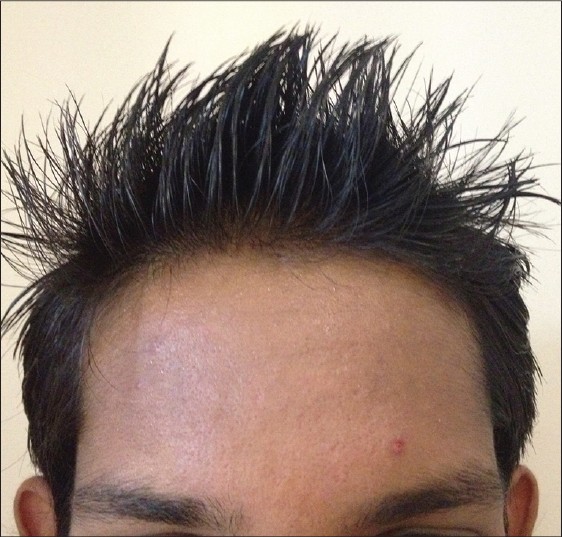 |
| Figure 2: Hair styled with hair gel |
Hair waxes
These are available as a wax containing copolymers, which are softer and can be evenly spread over dry hair for styling and can give an ′oily′ look.
Hair mousses
These are very popular because of their ease of use. Available as a foam in aerosolized cans, they contain a soft copolymer that gives a more natural look, with less ′hold′.
Pomades and brilliantine
Very popular with African-American people as a styling aid. These are products that contain vegetable/mineral oils, petrolatum, lanolin and waxes, and help in styling, moisturizing and conditioning the hair. They are comedogenic. Brilliantines are liquid pomades and newer formulations have better slip, as they contain silicones.
′Shine′ sprays
These contain silicones, hydrolyzed animal proteins, and cationic amino acid derivatives, and leave a shine when sprayed on damaged hair. These are very useful for hair that has become dry and lusterless.
′Heat protective′ products
Hair styling treatments using thermal energy can easily damage the hair, especially when wet. Specialized products have been designed to address this particular problem. They contain conditioning polymers such as silicon, petrolatum, and mineral oil, which function primarily by forming light-weight films. These act as thermal barriers and offer some degree of protection.
′Camouflage′ products
Patients with hair loss have a decreased quality of life (QoL) and as treating physicians, dermatologists should address this aspect of hair loss. [18] Several cosmetic products are available to be used by the individual to conceal the alopecia, for example, Toppik (keratin fibers) and Hairouse (cellulose fibers). These come in various shades of brown and black, and can be sprinkled on the bald areas. Static electricity make the fibers adhere to each other and the hair on the scalp, thus effectively concealing the bald area. Similarly, ′cover sticks′ made of waxes and pigment can be used by individuals who wish to conceal the ′gray show′ between two sessions of hair coloring [Figure - 3].
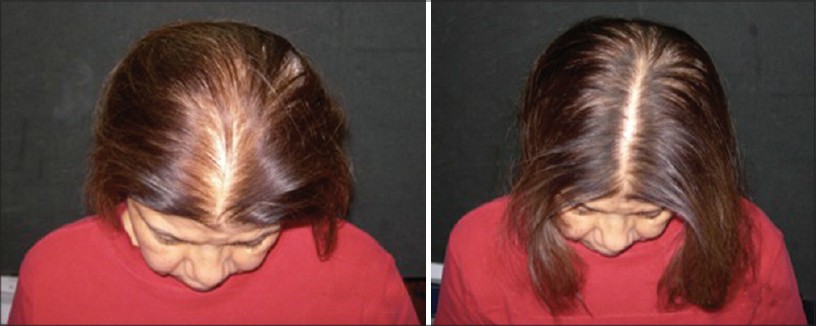 |
| Figure 3: (a and b) Cosmetic camoufl age with a cover-stick: Before and immediately after application |
Category 2
These include hair cosmetics that work on the cortex or alter the structural integrity of the hair shaft and include hair colors, bleaching agents, straightening, and perming agents.
Hair colors
Youth is represented by absence of gray hair. Graying becomes obvious when at least 20% of hair loses pigment. In the quest for looking young, research has focused on providing us with several options for covering gray hair/changing hair color temporarily or permanently. Hair coloring molecules are of different sizes, with the larger molecules mainly getting deposited on the hair shaft as a temporary or semi-permanent color. In order for a hair dye to be termed ′permanent′ the molecules should be capable of penetrating into the cortex and remaining there.
Gradual hair dyes
These are home-use products, which give the desired color after several days of use. The product has to be applied daily on the hair till the desired shade is reached. The patient then stops the applications, but would need to restart once the shade starts fading off. The gradual hair colors contain salts of metals (lead, silver or bismuth) in a liquid form, which when applied to the hair, leave behind the metallic salts as sulfides, oxides, and suboxides. Compliance is not very good because of the messiness of application, but these are useful for individuals who are allergic to para-phenylenediamine (PPD). The end result is dull hair with a ′not-perfect′ shade of color, which fades off faster and requires constant reapplication. In addition, hair that has been colored with these gradual dyes cannot be subjected to chemical perming or straightening procedures. Some examples of gradual hair dyes available in the Indian market are ′Vegetal′ (non-PPD) and ′Godrej Kesh Kala′ (PPD-containing).
Temporary hair dyes
These are useful to brighten the original hair shade, to add a tint, or enhance dyed hair. They get washed off with water and barely last till the next hair wash. They use textile acid dyes (FDC and DC dyes). Their large molecular size, keeps them outside the cuticle, keeping the cortex and medulla unaffected [Figure - 4].
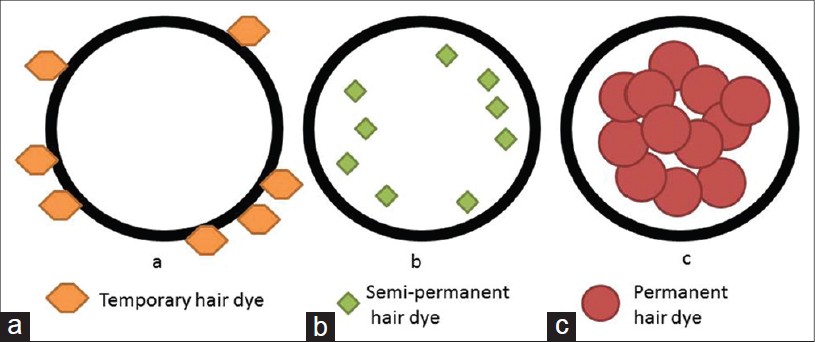 |
| Figure 4: Depth of penetration of hair dyes a. Larger molecules of temporary hair dyes are unable to penetrate into the cortex b. Smaller molecules of semi-permanent hair dyes easily penetrate into the cortex, but diffuse out easily in the subsequent washes c. Smaller dye precursors penetrate into the cortex and undergo oxidation to form large colored molecules that remain within the cortex and are unable to diffuse out |
′Silver shampoo′ is an example of a temporary dye used by women with all gray hair to give a silver hair look. The purple and blue dye colors in the silver shampoo, camouflage the dull yellow stain, which these hair develop when combined with sebum and sweat.
Semi-permanent hair dyes
These are water soluble, non-ionic, low molecular mixtures of pre-formed dyes, [19] the numbers of which vary depending on the shade required. These do not require hydrogen peroxide. They are usually anthraquinone, aromatic amines or aminonitrobenzenes, and may contain up to 18 component dyes to obtain the required shade. The product is applied to shampooed and towel-dried hair, left on for 20 minutes and then rinsed off. A conditioner is used post-shampooing. The color gets reduced with each shampoo and is completely washed off in six to eight shampoos. A patch test is required prior to the use of these dyes.
Demi-permanent hair colors
These are gentler on the hair than the permanent colors as they do not contain ammonia, and have a lower concentration of hydrogen peroxide (2%) as compared to permanent hair dyes (6%). [20] Hence, the irritation to the scalp and damage to the hair shaft is reduced. They are effective in covering gray hair, but not in lightening the hair shade.
Permanent hair dyes
Permanent hair colors are the most commonly used hair colors, because of their longevity, ease of use, and ability to have a range of color shades. These are also superior for gray cover, as the result is permanent and does not get washed off. This is an oxidation reaction that requires the combination of para dyes (para-phenylenediamine, para-toluenediamine, and para-aminophenol, known as the primary intermediaries) with hydrogen peroxide [Table - 3] to liberate oxygen. This process takes place inside the cortex and the entry is facilitated by ammonia. In ammonia-free hair dyes this work is performed by other alkaline agents like sodium carbonate and ethanolamine. The primary intermediaries are smaller molecules that can pass through the cuticular cells. Once inside the cortex, they combine with couplers, which are aniline dyes, to produce the required color molecules. As these color molecules are large, they cannot pass out through the cuticle, and remain firmly bound in the cortex. A change of shade from dark to light and the reverse is possible. The color remains in the hair, and a touch-up of roots may be required after six to eight weeks depending on the rate of growth. It is important for the ′touch-up′ process to treat only the new growth, as the older hair shaft color may darken due to re-application. As PPD derivatives can cause allergic reactions, a patch test is necessary before using a permanent hair dye. Of late, PPD is being incorporated into henna to give a deeper color and is marketed as black henna ( kali mehendi). Permanent hair colors are available as liquids, gels, and creams. A home-use pack contains two bottles that contain colorless liquids (hydrogen peroxide and a primary intermediary in combination with surfactants, conditioner, and so on). The two are mixed in equal proportion and applied immediately to the hair. Any left-over mixture must be discarded. The proportion of combination is 1:1. Some home-use packs are available in powder form, which has to be reconstituted with water. Here, the oxidizing agent is either sodium or potassium perborate in powdered form. The final pH achieved is 8-9.

Patch test for semi-permanent and permanent hair colors
The hair dye test can be an ′open′ test or one using the epicutaneous patch test.
Open test: On a clean area behind the ear or on the forearm just below the elbow, the dye mix is applied with a cotton swab and allowed to dry. If there is no reaction in 48 to 72 hours, the dye mix can be safely used on the scalp.
The epicutaneous patch test is the gold standard. This is done with 2% PPD in petrolatum. The result is read at 24 hours. A 1+ to 3+ indicates allergy to PPD. Recently, an in vitro assay using patient′s peripheral blood mononuclear cells has been developed with a sensitivity of 100%. [21]
Cross reactions
Patients sensitive to PPD may possibly cross react with compounds listed in [Table - 4].
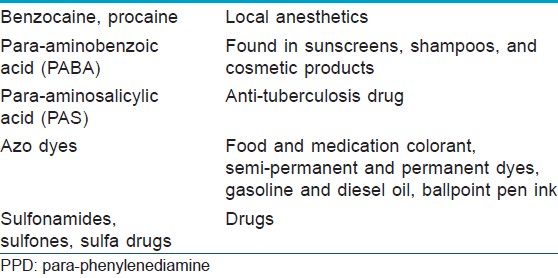
Safety regulations for para-phenylenediamine
The European Commission Directive 2009 regulation directs that the maximum concentration of hair dye substances in oxidative hair dyes should not exceed 2%. [22] This may be true for hair dye regulations, but studies attempting to quantify the percentage of PPD in decorative henna tattoos have shown alarming levels varying between 1-64%. [23],[24]
Side-effects of hair dyes
Most reactions to hair dye are due to the PPD content. The role of ammonia is to facilitate dye penetration, and ammonia-free dyes, although gentler to the hair shaft, do not prevent PPD reactions. Hair dye reactions most commonly present as allergic or irritant contact dermatitis. Some patients may experience photoallergic dermatitis. [21] Dye-induced depigmentation is not uncommon [25] and tends to run along the hairline. With subsequent exposures, there may be a more widespread presentation. Hair dyes change the texture of the hair by stripping off the 18-MEA layer, and thus, making it coarse and dull. PPD in permanent hair dyes induces apoptosis of cells and thus contributes to hair fall. [26],[27] Uncommon reactions include lymphomatoid reaction, erythema multiforme, [28] and even anaphylaxis [29] following hair dye application.
Hair dye and cancer risk
There is considerable debate on the association between the use of hair dye and development of cancer. It started in the 1970s, with the observation that permanent hair dyes contain certain chemicals that were structurally similar to aromatic amines known to cause bladder cancer. [30] This was especially true for hair dyes manufactured before 1980, when there were no restrictions on the manufacturing process. After the US Food and Drug Administration (FDA) placed regulatory guidelines on hair dye formulation in 1980, there has been a significant change in hair dye composition. Most recent studies and reviews of the meta-analysis do not support a causal relationship between personal hair dye use and bladder malignancies. [31],[32] However, hairdressers still remain at a higher risk. [33] Few reports link an increased incidence of Follicular Lymphoma (a variant of Non-Hodgkin′s Lymphoma (NHL)) in patients using permanent hair dyes, but this is again true for those using hair dyes prior to 1980. [34],[35] Also, it has been proposed that a possible genetic variation in the N-acetyltranfeferase enzyme may be an underlying predisposing factor for development of NHL in certain groups of patients applying hair dyes. [36] Use of hair colors does not appear to increase the risk of development of breast cancer. [37]
Indian hair dyes
Several hair dyes are available in India for home use, for example, Bigen, Godrej Hair Color, L′Oreal excellence, Garnier ammonia-free, and for salon use, Wella, Majirel, Inoa, and so on. Most of these have PPD as an active ingredient and sensitivity testing is recommended for most of then before every use. Bigen contains 2-nitro-P-phenylenediamine Sulfate and 4-nitro-O-phenylenediamine sulfate as PPD derivatives, with sodium perborate as the oxidizing agent. It is mixed with water and then applied. The percentage of PPD is not more than 0.98% when mixed. Various home-use formulations (containing PPD) are available, some as surfactant-based and some are with additional conditioning agents. The Godrej hair color although labeled as ′herbal-based′, recommends a skin sensitivity test. It is a powder formulation, which when mixed with water, has a PPD content of not more than 1.5%. In this case, herbs are added for improving the quality of the hair [Figure - 5].
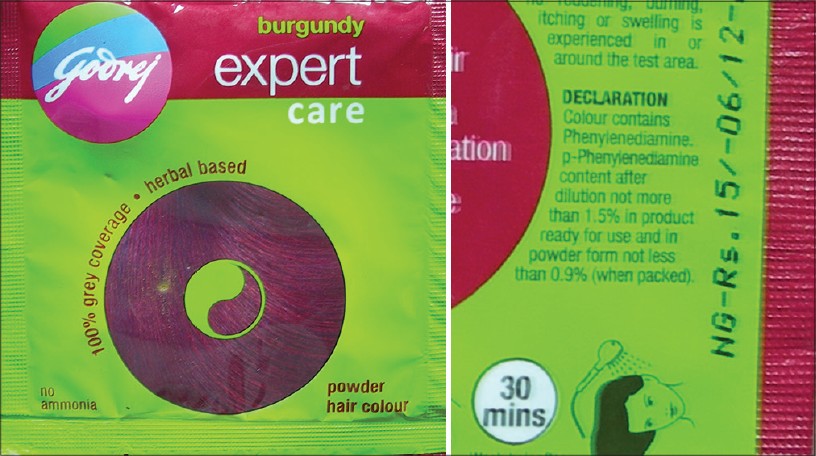 |
| Figure 5: Locally available herbal-based permanent hair dye containing para-phenylenediamine. (a) (Inset) [close up image showing the para-phenylenediamine content declaration] |
Vegetable dyes
A number of herbal and Ayurvedic dyes are available in India under various trade names such as Black Rose hair dye herbal (claims herbal, but advocates sensitivity test), Optima Hair dye (PPD and ammonia-free, but contains para-toluenediamine sulfate), Khadi dye (contains henna), Vegetal (contains henna and other herbs), and Indus Valley hair color, among others. Henna ( Lawsonia alba), is a natural organic substance, which is popular in India for decorative temporary tattoos and for coloring gray hair. The active ingredient is 2-hydroxy 1,4 napthaquinone. The active ingredient is obtained by treating the leaves with sodium bicarbonate. It is available as a powder that is mixed with coffee powder, and made into a paste with black tea water, allowed to stand for a couple of hours, and then applied to the hair. The contact time is a couple of hours, after which the hair is washed and shampooed. This process is useful for people allergic to para dyes. It is a messy process, and the henna leaves a strong odor in the hair that lasts several days. The end result is dry hair with an orange-red tint. The color fades gradually with shampooing and has to be reapplied as and when required. Although relatively inert, bullous allergic contact dermatitis (ACD) has been reported in a three-year-old child. [38] A locally available black hair dye by Godrej is marketed as completely natural and contains reetha (soapnut), shikakai (Acacia concinna), bhringraj ( Eclipta prostrata), mehendi (henna) and aamla (Indian gooseberry). Shikakai and reetha act as natural cleansing agents, mehendi as a natural colorant/conditioner, and aamla as a natural hair darkener. Over the last few years, ′black henna′ is being used for decorative, ′instant′ tattoos at events and tourist attraction spots. These contain, in addition to the henna, a para dye, and thus, can cause allergic reactions. Several such cases have been reported. [39]
Indigofera tinctoria is a natural dye that is available for commercial use as a green powder. It is mixed with water and applied the same way as henna; When mixed with henna, the color results are superior. Interestingly, the indigo dye in Morocco is used for coloring Moroccan handicrafts blue. A case of fatal poisoning has been reported following administration of indigo to a child for therapeutic purposes. [40]
Options for individuals allergic to para-phenylenediamine
Semi-permanent dyes may be an alternative, but 10% may be allergic to them too. A patch test is recommended. Dyes containing para-toluenediamine sulfate (PTDS) may be an option found in newer semi-permanent and permanent dyes and upto 50% may be able to tolerate it. [41] Metallic dyes and pure henna are other options. These are not very popular because of the final color obtained.
Hair bleaching
This is a process used when the individual is unhappy with the existing hair color, and wants to go lighter (all scalp hair), or wants to get hair highlighted in streaks (small sections of hair). It involves two steps, namely, stripping hair of all eumelanin, and then using a toner to get the required shade. This process is capable of only bleaching eumelanin and not pheomelanin. A mix of hydrogen peroxide and ammonia (with/without ammonium/potassium persulfate as a booster) is used for opening up the cuticle and stripping the eumelanin from the cortex. When extreme color change is done, that is, from black or dark brown to blonde, the process requires boosters that can result in severe damage to the hair shaft. Hair bleaching is a time-bound process where the hairdresser checks the color of the hair every 10 to 15 minutes. The total duration depends on the final color required. The hair is then washed with a specialized shampoo. The next step is the application of the hair color that may be a semi-permanent or a permanent dye. This is left on for half an hour and the hair is rinsed with water to remove all color. Conditioning is necessary as the hair structure is now damaged and brittle. This process is called ′toning′. [42]
Hair highlighting
Highlighting is a process by which isolated sections of hair are either lightened or darkened. This is done by the ′foil method,′ where strands of hair are separated by a comb and laid over an aluminum foil sheet, and then painted with a mixture of hydrogen peroxide and pigment [Figure - 6]a. The foil is then folded, and the contact time depends upon the shade required. Every 10 to 15 minutes, the foil is unfolded to check the degree of lightening. The remaining steps are as mentioned earlier. The result is an enhanced esthetic appearance [Figure - 6]b. Peters reported a burn following hair highlighting using foil. [43] Often darker hair has to be bleached first and then colored. This highlighting can also be done with a brush or spray, which contains semi-permanent or permanent color. Various coloring styles are used to enhance the overall aesthetic appeal. Dip dyeing [Figure - 7] is a process where only the hair ends are colored with a dye different from the base hair color. Ombré (French: Shaded) is a new trend where hair is dyed to give a shaded color [Figure - 8]. Chan and Maibach reviewed reports of eight cases with adverse reactions (chemical burns) caused by hair highlighting. The event was due to caustic chemical, thermal burn, or toxic reaction to the dye. [44]
 |
| Figure 6: (a) Silver foil used to isolate strands of hair for highlighting / bleaching (b) End result of the 'highlighting' process |
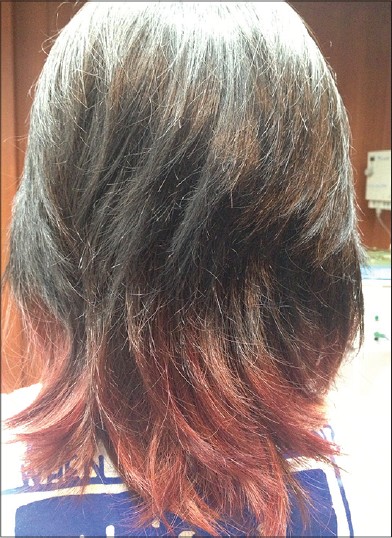 |
| Figure 7: Dip - dyeing is a new trend for hair color among the youth |
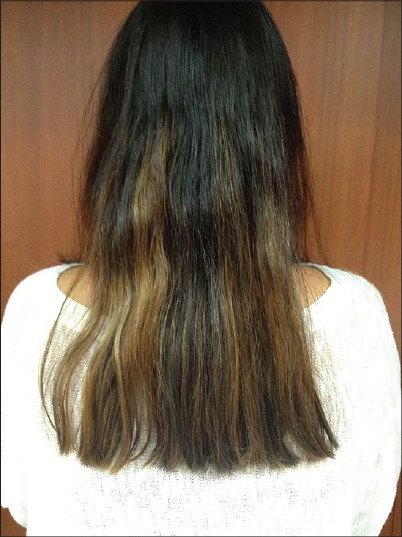 |
| Figure 8: Ombre is another popular hair dyeing style |
Hair bleaching products may cause severe systemic reactions or anaphylaxis [45] and can aggravate eczematous dermatitis especially in hairdressers. [46]
Fading of artificial hair color
Artificially colored hair is prone to fading when exposed to sunlight, shampooing, and chlorine exposure while swimming. Locke and Jachowicz simulated the actual usage conditions and demonstrated that the hair color maximally faded when exposed to both irradiation and shampooing. They also showed the photoprotective effects of UVA and UVB absorbers. [47] Such photoprotectors are incorporated in color-protect shampoo and conditioners. Schlosser tested the effect of various silicones directly incorporated into semi-permanent and permanent hair dyes for reducing the fading of colored hair or color change with UV exposure. The results indicated that dimethicone and dimethiconol prevented the color from fading, while propyl-phenyl silsesquioxane and trimethylsiloxysilicate decreased UV-exposure color change. [48],[49]
Hair straightening/perming
Hair perming and straightening are procedures that change the physical appearance of hair. By breaking down the di-sulfide bonds between the keratin filaments, both these processes alter the structural integrity and affect the cystine content of the hair. The bonds are then rearranged and reformed to give the desired shape of the hair. The process has to be repeated after three to four months. The important hydrophobic layer 18-MEA is permanently lost and is irreplaceable. Such hair becomes porous to water, swells easily, and loses its tensile strength.
Straightening (lanthionization) is a chemical process popular in people with frizzy or unmanageable hair, which results in at least 35% of the cysteine bonds changing to lanthionine. There is swelling of the shaft with lifting of the cuticles as the first step of the procedure. This is achieved with the use of strongly alkaline agents like 1.5 to 3.5% sodium/potassium hydroxide (lye-based), or guanidine/lithium hydroxide, (no-lye). As the lye-based straighteners cause great irritation, petrolatum needs to be applied to the scalp and hairline as protection, prior to the procedure. This is not required (except to the hairline) in non-lye based procedures. The pH of these straighteners varies between 12.5 and 14. This strong alkaline pH is caustic to the skin, scalp, and eyes, [50] and hence, should be handled only by professionals in a salon. Thioglycolic acid salts are increasingly being used as an alternative to ammonia, as reducing agents. They have a pH of 9-9.5 and are less caustic and provide good curling/straightening results. Home-use straightening products contain ammonium bisulfite + sulfite, have less alkaline pH (less than 9), and are safe to use, but their hair straightening ability is mild and the results are short-lived.
The hair is washed, hair protector spray applied, hair is partitioned in sections, and the softening agent applied by rubbing it in, and left on for half an hour, during which time the hair is constantly checked for the degree of softening. When the desired softening is achieved, the hair is rinsed and conditioner applied. The hair is then ′ironed′ between specialized tongs, and then a neutralizer is applied and kept on for 20 minutes. The hair is once again rinsed and dried. The next shampoo is advised after 24 hours, followed by conditioning. The final outcome can be very pleasing [Figure - 9].
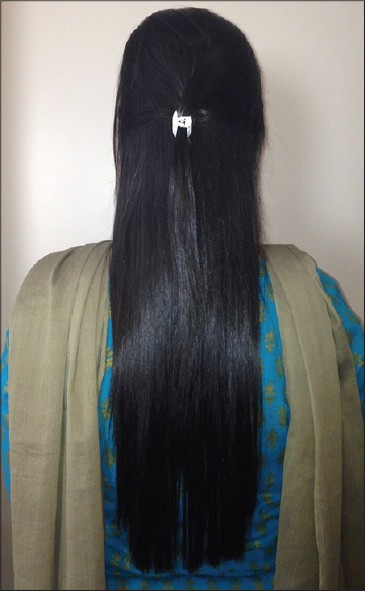 |
| Figure 9: Hair straightened with lanthionization |
Hair straightening can be very damaging to the hair and even when performed correctly, can result in loss of up to 20% of the tensile strength of virgin hair. It results in physical damage to the hair with loss of proteins and moisture resulting in dry, brittle hair. Many patients experience hair fall and breakage and may present to the clinic with alopecia. [51],[52] Hence, there is a need to use specialized hair care products, including shampoos and conditioners, post the procedure, to ensure minimal damage to the hair. [53] Just like with permanent hair dyes, there is a need to ′touch up′ the growing roots especially if the inherent hair are extremely curly. It is best to avoid repeated and frequent sessions, as damage by successive straightening is additive. It is advisable to perform deep conditioning of the hair every fortnight to protect the damaged hair. Hair straightening products may contain formaldehyde, which can cause skin and mucosal irritation. Newer products are available that are formaldehyde-free, and thus, safer for both the hair care professionals and patients.
Perming or permanent waving is a process by which straight hair is chemically treated to give long-lasting curls. The process is similar to that of straightening, with a few exceptions, and involves chemical softening, rearranging, and refixing the bonds. Mercaptans are used to soften the hair. Washed hair is first wound around rollers of the required diameter. The waving lotion is carefully applied to cover all the hair, and left on for 20 minutes to complete the softening process, where the disulfide bonds are broken. This process is then neutralized by applying an oxidizing agent for 15 minutes on the hair that are still wound around the rollers, and then for five more minutes with the rollers removed. The hair is then rinsed. Shampooing is advised two days later. The curls usually open a bit in a few weeks. A touch-up is required for the newly grown hair.
The use of hair oils and perming agents in early childhood have been shown to be associated with earlier menarche [54] and use of these hair products should be avoided in pre-pubertal/very young children.
Hair cosmetics in pregnancy
Couto et al., studied mothers of children with acute myeloid or lymphocytic leukemia (AML or ALL), and found a probable correlation between the use of hair dyes and hair straightening products during the first trimester of pregnancy and the development of AML or ALL. [55]
Although, no association was found in the pregnancy outcome of women who underwent chemical treatments such as straightening or curling the hair, [56] it was inferred that it was best to avoid such treatments during pregnancy.
Children with canites should not be encouraged to use semi-permanent or permanent hair dyes as they have a high risk of early sensitization.
Adverse effects in hairdressers
People working in salons as professional hair technicians are exposed to a much higher concentration of chemicals, increasing the risk of sensitization especially if use of gloves for wet work is inconsistent. [57] Eczematous hand dermatitis is their commonest complaint. [58] But of greater concern is the possibility of fertility disorders and adverse pregnancy outcomes. [59],[60] Safety recommendations for female hairdressers include working for less than 35 hours per week, and a well ventilated work place. [61] Hairdressers have a higher risk of respiratory complaints especially asthma. Ammonium persulfate salts, which are present in bleaching agents, have been implicated as the main etiological agents for the respiratory distress. [62] Hairdressers also suffer from musculoskeletal problems including shoulder, wrist and lower back pain which is work related. [63]
What is new in hair cosmetics?
Newer methods and products are being developed for improving the texture and softness of hair. The use of glycylglycine has shown good promise in this direction. [64] The use of silicon oil in a microemulsion preparation where the droplet size in ≤22.7 μm has been seen to improve the stability and deposition of silicon oil on the hair shaft. [65] Silicon oil-in-water nanoemulsions have shown to similarly improve silicon deposition on the hair shaft. [66] Newer products have been developed, which replenish the 18-MEA lost during various cosmetic hair procedures and attempt to improve the texture and strength of the individual hair shaft.
Hair cosmetics containing Argan oil have hit the market. These products claim to impart a nutritional benefit to the hair. The commercial preparations contain in addition to Argan oil, linseed oil and silicones, which themselves promote ′slip′ to the hair.
Alfa-hydroxy acids (e.g. glycolic and lactic acid) are being incorporated into hair care products (shampoos, conditioners, hair balms) [Figure - 10] to bring down the alkaline pH resulting from various hair cosmetic procedures. This allows smoothening of the cuticular cells, making the hair appear smooth and glossy.
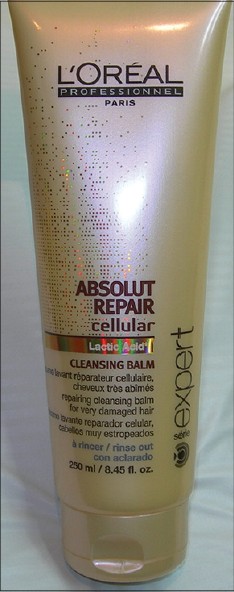 |
| Figure 10: Hair care product containing lactic acid, which helps to reduce pH |
A lot more products to prevent hair ′aging′ and color protection are being developed with UV reflectors/absorbers in their formulations.
An exciting innovation under development is the possibility of using dry thermal energy to transfer a powdered (azo) dye into the hair shaft as a method of hair color. [67] The source of heat could be a hair dryer, hot curling iron, or any other source. No more mess associated with liquid hair dyes. The time required to develop the final color would be minimal. A recently described delivery system, using non-ionic ethosomal vesicles, showed significantly better deposition of products on hair as compared to the traditional delivery systems. [68]
Conclusion
Newer products are in the pipeline, making the hair industry a continuously evolving one. As dermatologists specialized in hair care, the need of the day is to keep abreast with these developments, and keep a sharp eye out for adverse effects that may occur as a consequence of their usage.
Acknowledgment
We would like to acknowledge the valuable practical inputs by Ms Annie Chen, hairstylist.
| 1. |
Sinclair RD. Healthy hair: What is it? J Investig Dermatol Symp Proc 2007;12:2-5.
[Google Scholar]
|
| 2. |
Wolfram LJ. Human hair: A unique physicochemical composite. J Am Acad Dermatol 2003;48:S106-40.
[Google Scholar]
|
| 3. |
Kizawa K, Troxler H, Kleinert P, Inoue T, Toyoda M, Morohashi M, et al. Characterization of the cysteine-rich calcium-binding S100A3 protein from human hair cuticles. Biochem Biophys Res Commun 2002;299:857-62.
[Google Scholar]
|
| 4. |
Horvath AL. Solubility of structurally complicated materials: 3. Hair. Sci World J 2009;9:255-71.
[Google Scholar]
|
| 5. |
Dawber R. Cosmetic and medical causes of hair weathering. J Cosmet Dermatol 2002;1:196-201.
[Google Scholar]
|
| 6. |
Trüeb RM. Aging of hair. J Cosmet Dermatol 2005;4:60-72.
[Google Scholar]
|
| 7. |
Piérard-Franchimont C, Piérard GE. Hair weathering and hair capacitance mapping: A pilot study. J Cosmet Dermatol 2012;11:179-82.
[Google Scholar]
|
| 8. |
Hofbauer GF, Tsambaos D, Spycher MA, Trüeb RM. Acquired hair fragility in pili anulati: Causal relationship with androgenetic alopecia. Dermatology 2001;203:60-2.
[Google Scholar]
|
| 9. |
Draelos ZD. Essentials of hair care often neglected: Hair Cleansing. Int J Trichology 2010;2:24-9.
[Google Scholar]
|
| 10. |
Zawar VP, Mhaskar ST. Matting of hair following use of a new herbal shampoo. J Cosmet Dermatol 2003;2:42-4.
[Google Scholar]
|
| 11. |
Rele AS, Mohile RB. Effect of mineral oil, sunflower oil, and coconut oil on prevention of hair damage. J Cosmet Sci 2003;54:175-92.
[Google Scholar]
|
| 12. |
Stoll D, King LE Jr. Disulfiram-alcohol skin reaction to beer-containing shampoo. JAMA 1980;244:2045.
[Google Scholar]
|
| 13. |
Han H, Chen W, Li TS, Liu QS. Fetal death associated with ingestion of shampoo and development of hypotension and lactic acidosis. Clin Toxicol (Phila) 2012;50:793.
[Google Scholar]
|
| 14. |
Quertermous J, Fowler JF Jr. Allergic contact dermatitis from carvone in hair conditioners. Dermatitis 2010;21:116-7.
[Google Scholar]
|
| 15. |
Schalock PC, Storrs FJ, Morrison L. Contact urticaria from panthenol in hair conditioner. Contact Dermatitis 2000;43:223.
[Google Scholar]
|
| 16. |
Niinimäki A, Niinimäki M, Mäkinen-Kiljunen S, Hannuksela M. Contact urticaria from protein hydrolysates in hair conditioners. Allergy 1998;53:1078-82.
[Google Scholar]
|
| 17. |
Langan SM. Flares in childhood eczema. Skin Ther Lett 2009;14:4-5.
[Google Scholar]
|
| 18. |
Han SH, Byun JW, Lee WS, Kang H, Kye YC, Kim KH, et al. Quality of life assessment in male patients with androgenetic alopecia: Result of a prospective, multicenter study. Ann Dermatol 2012;24:311-8.
[Google Scholar]
|
| 19. |
Corbett JF. Hair dyes - their chemistry and toxicology. Cosmet Toilet 1976;91:21-28.
[Google Scholar]
|
| 20. |
Schlatter H, Neuser F. Hair dyes. In: Draelos Z, editor. Cosmetic Dermatology. Products and Procedures. 1 st ed. Singapore: Blackwell Publishing Ltd.; 2010. p. 227-35.
[Google Scholar]
|
| 21. |
Handa S, Mahajan R, De D. Contact dermatitis to hair dye: An update. Indian J Dermatol Venereol Leprol 2012;78:583-90.
[Google Scholar]
|
| 22. |
Commission Directive 2009/130/EC of 12 October 2009 amending Council Directive 76/768/EEC, concerning cosmetic products, for the purpose of adapting Annex III thereto to technical progress (Text with EEA relevance).
[Google Scholar]
|
| 23. |
Almeida PJ, Borrego L, Pulido-Melián E, González-Díaz O. Quantification of p-phenylenediamine and 2-hydroxy-1, 4-naphthoquinone in henna tattoos. Contact Dermatitis 2012;66:33-7.
[Google Scholar]
|
| 24. |
Brancaccio RR, Brown LH, Chang YT, Fogelman JP, Mafong EA, Cohen DE. Identification and quantification of para-phenylenediamine in a temporary black henna tattoo. Am J Contact Dermat 2002;13:15-8.
[Google Scholar]
|
| 25. |
Ghosh S, Mukhopadhyay S. Chemical leucoderma: A clinico-aetiological study of 864 cases in the perspective of a developing country. Br J Dermatol 2009;160:40-7.
[Google Scholar]
|
| 26. |
Chye SM, Tiong YL, Yip WK, Koh RY, Len YW, Seow HF, et al. Apoptosis induced by para-phenylenediamine involves formation of ROS and activation of p38 and JNK in chang liver cells. Environ Toxicol 2012. [In press].
[Google Scholar]
|
| 27. |
Ishida W, Makino T, Shimizu T. Severe hair loss of the scalp due to a hair dye containing Para phenylenediamine. ISRN Dermatol 2011;2011:9472-84.
[Google Scholar]
|
| 28. |
Koley S, Sarkar J, Choudhary S, Dhara S, Choudhury M. Erythema multiforme following application of hair dye. Indian J Dermatol 2012;57:230-2.
[Google Scholar]
|
| 29. |
Mavroleon G, Begishvili B, Frew AJ. Anaphylaxis to hair dye: A case report. Clin Exp Allergy 1998;28:121-2.
[Google Scholar]
|
| 30. |
Shafer N, Shafer RW. Potential of carcinogenic effects of hair dyes. N Y State J Med 1976;76:394-6.
[Google Scholar]
|
| 31. |
Saitta P, Cook CE, Messina JL, Brancaccio R, Wu BC, Grekin SK, et al. Is There a true concern regarding the use of hair dye and malignancy development?: A review of the epidemiological evidence relating personal hair dye use to the risk of malignancy. J Clin Aesthet Dermatol 2013;6:39-46.
[Google Scholar]
|
| 32. |
Bolt HM, Golka K. The debate on carcinogenicity of permanent hair dyes: New insights. Crit Rev Toxicol 2007;37:521-36.
[Google Scholar]
|
| 33. |
Harling M, Schablon A, Schedlbauer G, Dulon M, Nienhaus A. Bladder cancer among hairdressers: A meta-analysis. Occup Environ Med 2010;67:351-8.
[Google Scholar]
|
| 34. |
Sangrajrang S, Renard H, Kuhaprema T, Pornsopone P, Arpornwirat W, Brennan P. Personal use of hair dyes--increased risk of non-Hodgkin's lymphoma in Thailand. Asian Pac J Cancer Prev 2011;12:2393-6.
[Google Scholar]
|
| 35. |
Zhang Y, Sanjose SD, Bracci PM, Morton LM, Wang R, Brennan P, et al. Personal use of hair dye and the risk of certain subtypes of non-Hodgkin lymphoma. Am J Epidemiol 2008;167:1321-31.
[Google Scholar]
|
| 36. |
Morton LM, Bernstein L, Wang SS, Hein DW, Rothman N, Colt JS, et al. Hair dye use, genetic variation in N-acetyltransferase 1 (NAT1) and 2 (NAT2), and risk of non-Hodgkin lymphoma. Carcinogenesis 2007;28:1759-64.
[Google Scholar]
|
| 37. |
Cook LS, Malone KE, Daling JR, Voigt LF, Weiss NS. Hair product use and the risk of breast cancer in young women. Cancer Causes Control 1999;10:551-9.
[Google Scholar]
|
| 38. |
Belhadjali H, Akkari H, Youssef M, Mohamed M, Zili J. Bullous allergic contact dermatitis to pure henna in a 3-year-old girl. Pediatr Dermatol 2011;28:580-1.
[Google Scholar]
|
| 39. |
Rai VM, Shenoi S D. Pseudo-tattoo dermatitis. Indian J Dermatol Venereol Leprol 2006;72:232-4.
[Google Scholar]
|
| 40. |
Labib S, Berdai MA, Bendadi A, Achour S, Harandou M. Fatal poisoning due to Indigofera. Arch Pediatr 2012;19:59-61.
[Google Scholar]
|
| 41. |
Scheman A, Cha C, Bhinder M. Alternative hair-dye products for persons allergic to para-phenylenediamine. Dermatitis 2011;22:189-92.
[Google Scholar]
|
| 42. |
Corbett JF. Hair coloring processes. Cosmet Toilet 1991;106:53-7.
[Google Scholar]
|
| 43. |
Peters W. The hair color-highlighting burn: A unique burn injury. J Burn Care Rehabil 2000;21:96-8.
[Google Scholar]
|
| 44. |
Chan HP, Maibach HI. Hair highlights and severe acute irritant dermatitis ("burn") of the scalp. Cutan Ocul Toxicol 2010;29:229-33.
[Google Scholar]
|
| 45. |
Hoekstra M, van der Heide S, Coenraads PJ, Schuttelaar ML. Anaphylaxis and severe systemic reactions caused by skin contact with persulfates in hair-bleaching products. Contact Dermatitis 2012;66:317-22.
[Google Scholar]
|
| 46. |
Hougaard MG, Menné T, Søsted H. Occupational eczema and asthma in a hairdresser caused by hair-bleaching products. Dermatitis 2012;23:284-7.
[Google Scholar]
|
| 47. |
Locke B, Jachowicz J. Fading of artificial hair color and its prevention by photofilters. Int J Cosmet Sci 2006;28:231-2.
[Google Scholar]
|
| 48. |
Schlosser A. Silicones used in permanent and semi-permanent hair dyes to reduce the fading and color change process of dyed hair occurred by wash-out or UV radiation. J Cosmet Sci 2004;55 Suppl: S123-31.
[Google Scholar]
|
| 49. |
Lee HY, Jeong YI, Choi KC. Hair dye-incorporated poly-γ-glutamic acid/glycol chitosan nanoparticles based on ion-complex formation. Int J Nanomedicine 2011;6:2879-88.
[Google Scholar]
|
| 50. |
Smith RS, Shear G. Corneal alkali burns arising from accidental instillation of a hair straightener. Am J Ophthalmol 1975;79:602-5.
[Google Scholar]
|
| 51. |
Swee W, Klontz KC, Lambert LA. A nationwide outbreak of alopecia associated with the use of a hair-relaxing formulation. Arch Dermatol 2000;136:1104-8.
[Google Scholar]
|
| 52. |
Nicholson AG, Harland CC, Bull RH, Mortimer PS, Cook MG. Chemically induced cosmetic alopecia. Br J Dermatol 1993;128:537-41.
[Google Scholar]
|
| 53. |
Dias TC, Baby AR, Kaneko TM, Velasco MV. Protective effect of conditioning agents on Afro-ethnic hair chemically treated with thioglycolate-based straightening emulsion. J Cosmet Dermatol 2008;7:120-6.
[Google Scholar]
|
| 54. |
James-Todd T, Terry MB, Rich-Edwards J, Deierlein A, Senie R. Childhood hair product use and earlier age at menarche in a racially diverse study population: A pilot study. Ann Epidemiol 2011;21:461-5.
[Google Scholar]
|
| 55. |
Couto AC, Ferreira JD, Rosa AC, Pombo-de-Oliveira MS, Koifman S; Brazilian Collaborative Study Group of Infant Acute Leukemia. Pregnancy, maternal exposure to hair dyes and hair straightening cosmetics and early age leukemia. Chem Biol Interact 2013;205:46-52.
[Google Scholar]
|
| 56. |
Blackmore-Prince C, Harlow SD, Gargiullo P, Lee MA, Savitz DA. Chemical hair treatments and adverse pregnancy outcome among Black women in central North Carolina. Am J Epidemiol 1999;149:712-6.
[Google Scholar]
|
| 57. |
Lysdal SH, Johansen JD, Flyvholm MA, Søsted H. A quantification of occupational skin exposures and the use of protective gloves among hairdressers in Denmark. Contact Dermatitis 2012;66:323-34.
[Google Scholar]
|
| 58. |
Khumalo NP, Jessop S, Ehrlich R. Prevalence of cutaneous adverse effects of hairdressing: A systematic review. Arch Dermatol 2006;142:377-83.
[Google Scholar]
|
| 59. |
Peters C, Harling M, Dulon M, Schablon A, Torres Costa J, Nienhaus A. Fertility disorders and pregnancy complications in hairdressers-A systematic review. J Occup Med Toxicol 2010;5:24.
[Google Scholar]
|
| 60. |
Rylander L, Källén B. Reproductive outcomes among hairdressers. Scand J Work Environ Health 2005;31:212-7.
[Google Scholar]
|
| 61. |
Chua-Gocheco A, Bozzo P, Einarson A. Safety of hair products during pregnancy: Personal use and occupational exposure. Can Fam Physician 2008;54:1386-8.
[Google Scholar]
|
| 62. |
Pignatti P, Frossi B, Pala G, Negri S, Oman H, Perfetti L, et al. Oxidative activity of ammonium persulfate salt on mast cells and basophils: Implication in hairdressers' asthma. Int Arch Allergy Immunol 2013;160:409-19.
[Google Scholar]
|
| 63. |
Bradshaw L, Harris-Roberts J, Bowen J, Rahman S, Fishwick D. Self-reported work-related symptoms in hairdressers. Occup Med (Lond) 2011;61:328-34.
[Google Scholar]
|
| 64. |
Breakspear S, Fukuhara M, Itou T, Hirano Y, Nojiri M, Kiyomine A, et al. Alignment control and softness creation in hair with glycylglycine. J Cosmet Sci 2013;64:19-33.
[Google Scholar]
|
| 65. |
Nazir H, Lv P, Wang L, Lian G, Zhu S, Ma G. Uniform-sized silicone oil microemulsions: Preparation, investigation of stability and deposition on hair surface. J Colloid Interface Sci 2011;364:56-64.
[Google Scholar]
|
| 66. |
Hu Z, Liao M, Chen Y, Cai Y, Meng L, Liu Y, et al. A novel preparation method for silicone oil nanoemulsions and its application for coating hair with silicone. Int J Nanomedicine 2012;7:5719-24.
[Google Scholar]
|
| 67. |
US Patent Number US7722680 B2; Dyeing of human keratin materials by dry thermal transfer of a direct dye, composition comprising the said dye and its method of preparation, 25 May 2010.
[Google Scholar]
|
| 68. |
Yeh MI, Huang HC, Liaw JH, Huang MC, Wu TH, Huang KF, et al. Ethosomes in hair dye products as carriers of the major compounds of black tea extracts. Int J Dermatol 2013;52:868-75.
[Google Scholar]
|
Fulltext Views
30,462
PDF downloads
8,018





